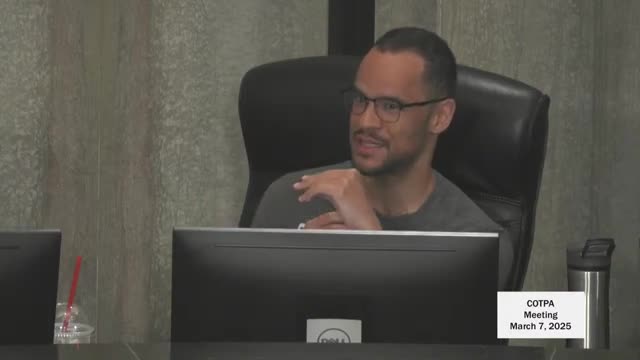Advocates highlight ADA accessibility issues during city meeting with Jeremy on mobility challenges
March 08, 2025 | Other Public Meetings, Oklahoma City, Oklahoma County, Oklahoma
This article was created by AI summarizing key points discussed. AI makes mistakes, so for full details and context, please refer to the video of the full meeting. Please report any errors so we can fix them. Report an error »

In a recent meeting of the Central Oklahoma Transportation and Parking Authority, a poignant discussion unfolded, highlighting the ongoing challenges of accessibility in Oklahoma City. The conversation was sparked by a powerful personal story shared by a council member, who recounted an encounter with Jeremy, a local resident who uses a wheelchair and relies on public transportation.
The council member described how Jeremy attempted to visit a bookstore but was thwarted by the building's lack of ADA accessibility. This moment served as a catalyst for a deeper exploration of the city's infrastructure and its impact on individuals with disabilities. As they walked together, the council member observed firsthand the difficulties Jeremy faced navigating the streets, particularly where sidewalks abruptly ended or were obstructed by boulders placed by residents.
The narrative took a historical turn as the council member reflected on the origins of the Americans with Disabilities Act (ADA), emphasizing the struggles of those who fought for accessibility rights. A particularly moving moment was shared, depicting activists physically propelling themselves up the steps of Congress to demand change. This imagery resonated with the council member's experience with Jeremy, reinforcing the importance of continued advocacy for accessible public spaces.
The discussion also touched on recent improvements made through the MAPS 4 initiative, which has funded new sidewalks in various neighborhoods. However, the council member expressed frustration over the remaining barriers that hinder mobility, such as the lack of continuous sidewalks and the presence of obstacles in public rights-of-way. The urgency of these issues was palpable, as the council member called for a collective effort to ensure that all residents, regardless of their mobility needs, can navigate the city safely and easily.
As the meeting concluded, it was clear that the journey toward full accessibility in Oklahoma City is ongoing. The stories shared not only highlighted the challenges faced by individuals with disabilities but also underscored the community's responsibility to advocate for inclusive infrastructure. The council member's passionate plea for change left attendees with a renewed sense of purpose, reminding everyone that the fight for accessibility is far from over.
The council member described how Jeremy attempted to visit a bookstore but was thwarted by the building's lack of ADA accessibility. This moment served as a catalyst for a deeper exploration of the city's infrastructure and its impact on individuals with disabilities. As they walked together, the council member observed firsthand the difficulties Jeremy faced navigating the streets, particularly where sidewalks abruptly ended or were obstructed by boulders placed by residents.
The narrative took a historical turn as the council member reflected on the origins of the Americans with Disabilities Act (ADA), emphasizing the struggles of those who fought for accessibility rights. A particularly moving moment was shared, depicting activists physically propelling themselves up the steps of Congress to demand change. This imagery resonated with the council member's experience with Jeremy, reinforcing the importance of continued advocacy for accessible public spaces.
The discussion also touched on recent improvements made through the MAPS 4 initiative, which has funded new sidewalks in various neighborhoods. However, the council member expressed frustration over the remaining barriers that hinder mobility, such as the lack of continuous sidewalks and the presence of obstacles in public rights-of-way. The urgency of these issues was palpable, as the council member called for a collective effort to ensure that all residents, regardless of their mobility needs, can navigate the city safely and easily.
As the meeting concluded, it was clear that the journey toward full accessibility in Oklahoma City is ongoing. The stories shared not only highlighted the challenges faced by individuals with disabilities but also underscored the community's responsibility to advocate for inclusive infrastructure. The council member's passionate plea for change left attendees with a renewed sense of purpose, reminding everyone that the fight for accessibility is far from over.
View full meeting
This article is based on a recent meeting—watch the full video and explore the complete transcript for deeper insights into the discussion.
View full meeting
